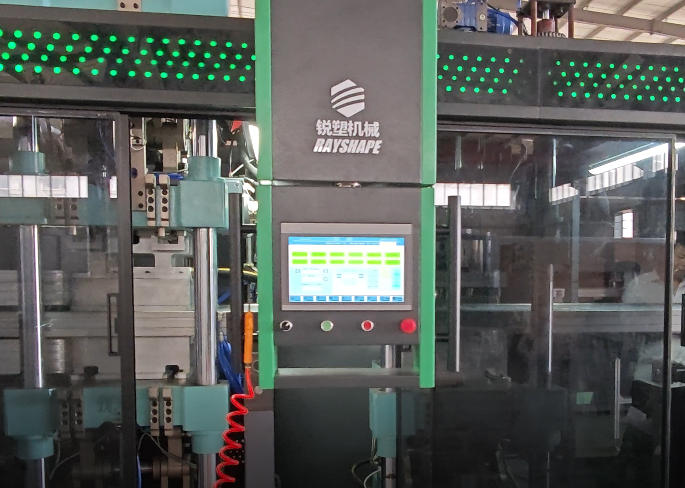Plastic thermoformers: The invisible artists shaping modern life
Plastic thermoformed products can be found in almost every corner of our daily lives: transparent breakfast boxes, fruit and vegetable trays in supermarkets, neatly arranged pill blisters in pharmacies, even car dashboards and refrigerator door liners. These diverse plastic products with diverse shapes and functions are mostly not manufactured through traditional injection molding or blow molding, but rather through a highly efficient and flexible processing technology: plastic thermoforming. The key equipment enabling this technology is the plastic thermoforming machine. Like an invisible artist, it transforms ordinary plastic sheets into practical works of art that embellish our lives.
I. Core Principle: The Wisdom of Hot Softness and Cold Hardness
 The principle of plastic thermoforming is intuitive and ingenious, and its core can be summarized in three steps: heating, forming, and cooling. First, a plastic sheet of fixed size (typically PVC, PET, PS, PP, ABS, etc.) is clamped to the thermoforming machine's frame. Next, the sheet is evenly and controllably heated by a heating system (such as electric heating tubes or infrared quartz tubes) mounted above the equipment, softening it to a "highly elastic" state with the desired elasticity.
The principle of plastic thermoforming is intuitive and ingenious, and its core can be summarized in three steps: heating, forming, and cooling. First, a plastic sheet of fixed size (typically PVC, PET, PS, PP, ABS, etc.) is clamped to the thermoforming machine's frame. Next, the sheet is evenly and controllably heated by a heating system (such as electric heating tubes or infrared quartz tubes) mounted above the equipment, softening it to a "highly elastic" state with the desired elasticity.
Next comes the crucial step: molding. Depending on the product and mold, two main methods are used:
Vacuum forming: This is the most common method. Tiny air extraction holes are located within the mold cavity. When the softened sheet is placed over the mold, a vacuum pump rapidly removes the air between the mold and the sheet, using atmospheric pressure to press the sheet tightly against the mold surface, perfectly replicating every detail of the mold.
Pressure forming: For products with more complex structures and demanding details (such as deep depth or fine textures), pressure forming is used. This method involves injecting compressed air above the sheet, using strong positive pressure to "push" the softened sheet into the mold, resulting in greater molding force and improved product quality.
Finally, the mold's cooling system (either water or air) rapidly cools and solidifies the formed sheet. The sheet is then demolded and, after trimming, the finished product is obtained.
II. Main Types: From Fully Automatic to Simple
To accommodate varying production scales and budgets, thermoforming machines have evolved into various types:
Fully automatic thermoforming machines: These are the core of modern large-scale production. From sheet loading, heating, forming, cooling, demolding, to cutting, all processes are integrated into a single production line, resulting in a high degree of automation. With production rates reaching thousands of parts per hour, they are a staple in high-volume, high-sanitation industries such as food packaging and medical devices.
Semi-automatic thermoforming machines: Suitable for small to medium-sized batch production. Manual loading and unloading or part removal are typically required, and their cost and flexibility lie somewhere between fully automatic and manual, making them an ideal choice for startups and those producing diverse products.
Manual/benchtop thermoforming machines: With their simple structure and easy operation, they are primarily used for design proofing, educational demonstrations, small-scale craft production, or small-batch custom production. They provide a low-barrier tool for bringing creative ideas to life.
III. Advantages and Challenges: Why choose thermoforming? Compared to injection molding, thermoforming technology offers unique advantages:
Low mold cost: Thermoforming molds (typically aluminum or resin molds) are relatively simple in structure, have a short manufacturing cycle, and are significantly less expensive than the steel molds required for injection molding. This significantly improves the economic feasibility of developing new products or producing small batches.
High production efficiency: Thermoforming cycles are very short, especially for large-area, thin-walled products, resulting in outstanding production efficiency.
Excellent product performance: Thermoformed products exhibit minimal molecular orientation and low internal stress during the molding process, resulting in excellent dimensional stability and impact resistance.
Capable of producing very large products: Thermoforming is virtually the only efficient plastic processing method for producing large products such as refrigerator liners, automobile exteriors, bathtubs, and advertising light boxes.
However, it also has limitations, primarily the limited raw material form (sheets are required) and the generation of scrap, resulting in material utilization rates generally inferior to injection molding. IV. Application Areas: Ubiquitous Contribution
Thermoforming technology has an extremely wide range of applications:
Food packaging: Disposable cup lids, fast food containers, fruit trays, beverage cups, chocolate boxes, etc. are the largest application market.
Medical devices: Sterile blister packaging (providing a sterile barrier for surgical instruments, syringes, etc.), denture trays, medical utensils, etc.
Consumer goods: Electronic product packaging trays, toys, stationery, cosmetic boxes, refrigerator liners, bathroom fixtures, etc.
Advertising and Architecture: Light boxes, signage, decorative panels, etc.
V. Future Trends: Towards Green and Intelligent
With the wave of Industry 4.0 and sustainable development, plastic thermoforming machines are developing in the following directions:
Intelligent and digital: Integrating more sophisticated temperature and pressure sensors and PLC control systems enables precise control and remote monitoring of process parameters, optimizing production efficiency and reducing scrap through big data analysis. Energy-saving and high-efficiency: Develop more efficient heating methods (such as electromagnetic heating) and insulation technologies to optimize energy utilization; improve mechanical design to increase operating speed.
Environmental protection: Actively adapt to the processing needs of biodegradable materials (such as PLA), improve equipment to better handle recycled materials (such as rPET), and support the circular economy from the source.

I. Core Principle: The Wisdom of Hot Softness and Cold Hardness

Next comes the crucial step: molding. Depending on the product and mold, two main methods are used:
Vacuum forming: This is the most common method. Tiny air extraction holes are located within the mold cavity. When the softened sheet is placed over the mold, a vacuum pump rapidly removes the air between the mold and the sheet, using atmospheric pressure to press the sheet tightly against the mold surface, perfectly replicating every detail of the mold.
Pressure forming: For products with more complex structures and demanding details (such as deep depth or fine textures), pressure forming is used. This method involves injecting compressed air above the sheet, using strong positive pressure to "push" the softened sheet into the mold, resulting in greater molding force and improved product quality.
Finally, the mold's cooling system (either water or air) rapidly cools and solidifies the formed sheet. The sheet is then demolded and, after trimming, the finished product is obtained.
II. Main Types: From Fully Automatic to Simple
To accommodate varying production scales and budgets, thermoforming machines have evolved into various types:
Fully automatic thermoforming machines: These are the core of modern large-scale production. From sheet loading, heating, forming, cooling, demolding, to cutting, all processes are integrated into a single production line, resulting in a high degree of automation. With production rates reaching thousands of parts per hour, they are a staple in high-volume, high-sanitation industries such as food packaging and medical devices.
Semi-automatic thermoforming machines: Suitable for small to medium-sized batch production. Manual loading and unloading or part removal are typically required, and their cost and flexibility lie somewhere between fully automatic and manual, making them an ideal choice for startups and those producing diverse products.
Manual/benchtop thermoforming machines: With their simple structure and easy operation, they are primarily used for design proofing, educational demonstrations, small-scale craft production, or small-batch custom production. They provide a low-barrier tool for bringing creative ideas to life.
III. Advantages and Challenges: Why choose thermoforming? Compared to injection molding, thermoforming technology offers unique advantages:
Low mold cost: Thermoforming molds (typically aluminum or resin molds) are relatively simple in structure, have a short manufacturing cycle, and are significantly less expensive than the steel molds required for injection molding. This significantly improves the economic feasibility of developing new products or producing small batches.
High production efficiency: Thermoforming cycles are very short, especially for large-area, thin-walled products, resulting in outstanding production efficiency.
Excellent product performance: Thermoformed products exhibit minimal molecular orientation and low internal stress during the molding process, resulting in excellent dimensional stability and impact resistance.
Capable of producing very large products: Thermoforming is virtually the only efficient plastic processing method for producing large products such as refrigerator liners, automobile exteriors, bathtubs, and advertising light boxes.
However, it also has limitations, primarily the limited raw material form (sheets are required) and the generation of scrap, resulting in material utilization rates generally inferior to injection molding. IV. Application Areas: Ubiquitous Contribution
Thermoforming technology has an extremely wide range of applications:
Food packaging: Disposable cup lids, fast food containers, fruit trays, beverage cups, chocolate boxes, etc. are the largest application market.
Medical devices: Sterile blister packaging (providing a sterile barrier for surgical instruments, syringes, etc.), denture trays, medical utensils, etc.
Consumer goods: Electronic product packaging trays, toys, stationery, cosmetic boxes, refrigerator liners, bathroom fixtures, etc.
Advertising and Architecture: Light boxes, signage, decorative panels, etc.
V. Future Trends: Towards Green and Intelligent
With the wave of Industry 4.0 and sustainable development, plastic thermoforming machines are developing in the following directions:
Intelligent and digital: Integrating more sophisticated temperature and pressure sensors and PLC control systems enables precise control and remote monitoring of process parameters, optimizing production efficiency and reducing scrap through big data analysis. Energy-saving and high-efficiency: Develop more efficient heating methods (such as electromagnetic heating) and insulation technologies to optimize energy utilization; improve mechanical design to increase operating speed.
Environmental protection: Actively adapt to the processing needs of biodegradable materials (such as PLA), improve equipment to better handle recycled materials (such as rPET), and support the circular economy from the source.








